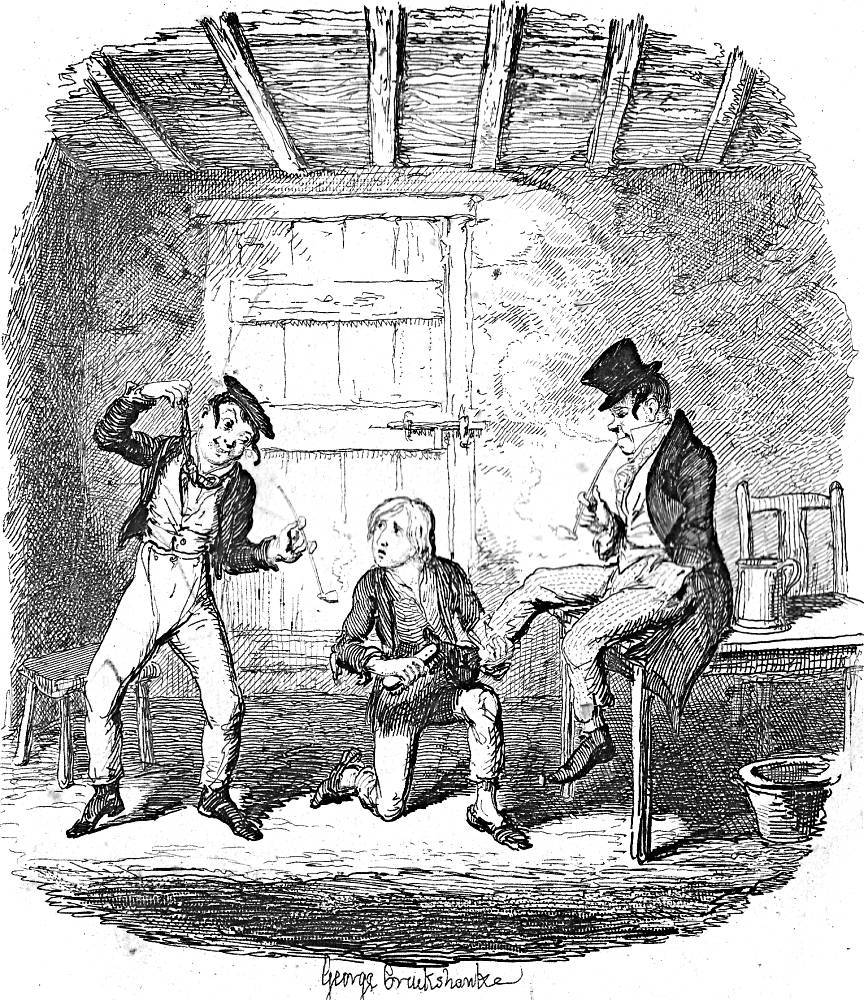"The Artful Dodger and Charley Bates," fifth illustration for "Oliver Twist" by Sol Eytinge, Jr. (original) (raw)
Passage Illustrated: The Artful and his Side-kick
One afternoon, the Dodger and Master Bates being engaged out that evening, the first-named young gentleman took it into his head to evince some anxiety regarding the decoration of his person (to do him justice, this was by no means an habitual weakness with him); and, with this end and aim, he condescendingly commanded Oliver to assist him in his toilet, straightway.
Oliver was but too glad to make himself useful; too happy to have some faces, however bad, to look upon; too desirous to conciliate those about him when he could honestly do so; to throw any objection in the way of this proposal. So he at once expressed his readiness; and, kneeling on the floor, while the Dodger sat upon the table so that he could take his foot in his laps, he applied himself to a process which Mr. Dawkins designated as "japanning his trotter-cases." The phrase, rendered into plain English, signifieth, cleaning his boots. [Chapter 18, "How Oliver passed his time in the improving society of his reputable friends," p. 79]
Commentary: The Inimitable "Artful Dodger" (Jack Dawkins)
Other illustrators have depicted Oliver's dubious companions in Fagin's crib with greater effectiveness, and usually in the act of committing petty thefts, as in George Cruikshank's original 1837 serial plate, Oliver amazed at the Dodger's mode of going to work. Eytinge, however, employs contrast to distinguish their characters.
Fagin directs a string of street gypsies, but the only two who stand out are the quick-witted pickpocket Jack Dawkins (otherwise, "The Artful Dodger," a sobriquet doubtless conferred by Fagin himself) and Charley Bates, far more benign and facetious figures than Fagin's chief criminal associate, the burglar Bill Sikes. For all his wit and "artfulness," Dawking is sentenced to transportation for life to New South Wales, Britain's Australian penal colony. However, Dickens fashions a very different fate for Charley, whose explication of a professional technicality betrays his fear of hanging for his many petty thefts: at the close of the story, Charley reforms, returns to his rural roots as a grazier, becoming a prosperous burgess over time in his native Northamptonshire.
Dressed on cast-off adult clothing, Charley and the Dodger look a bit like the anonymous street waif depicted in John Leech's 1843 political cartoonSubstance and Shadow (left, inspecting a painting) from Punch Magazine. However, the Eytinge rogues are better dressed and less ill-kempt, although the American illustrator captures their grittier natures as he depicts them as street toughs in miniature, smoking, drinking (note the pot of porter on the table, left), and posturing. Purely to distinguish one from the other, Eytinge has Charley (right) laughing, and the Dodger (left, tophat tilted rakishly askew) scowling. The decaying plaster in the background suggests that the boys are in Fagin's garret.
Relevant Illustrations from the serial and later editions (1838, 1871, 1885, and 1910)
Left: George Cruikshank's Master Bates explains a professional technicality (1838). Centre: F. W. Pailthorpe's version of Oliver's meeting the Artful Dodger at Barnett: <spanclass="tcartwork">"Hullo, my covey! What's the row?" (1886). Right: Harry Furniss's Charles Dickens Library Edition illustration The Dodger's Toilet (1910). [Click on images to enlarge them.]</spanclass="tcartwork">
Above: James Mahoney's <spanclass="tcartwork">"Hullo, my covey! What's the row?" (1871). [Click on images to enlargethem.]</spanclass="tcartwork">
Bibliography
Bentley, Nicolas, Michael Slater, and Nina Burgis. The Dickens Index. New York and Oxford: Oxford U. P., 1990.
Cohen, Jane Rabb. "George Cruikshank." Charles Dickens and His Original Illustrators. Columbus: Ohio State U. P., 1980. Pp. 15-38.
Darley, Felix Octavius Carr. Character Sketches from Dickens. Philadelphia: Porter and Coates, 1888.
Davies, Philip. "Warren of Sunless Courts." Lost London, 1870-1945. Croxley Green, Hertfordshire: Transatlantic, 2009. Pp. 258- 260.
Davis, Paul. Charles Dickens A to Z: The Essential Reference to His Life and Work. New York: Facts On File, 1998.
Dickens, Charles. The Adventures of Oliver Twist; or, The Parish Boy's Progress. Illustrated by George Cruikshank. London: Bradbury and Evans; Chapman and Hall, 1846.
_______. Oliver Twist. Works of Charles Dickens. Household Edition. 55 vols. Illustrated by F. O. C. Darley and John Gilbert. New York: Sheldon and Co., 1865.
_______. The Adventures of Oliver Twist. Works of Charles Dickens. Diamond Edition. 14 vols. Illustrated by Sol Eytinge, Jr. Boston: Ticknor and Fields, 1867.
_______. Oliver Twist. 22 vols. Household Edition. Illustrated by James Mahoney. London: Chapman and Hall, 1871. Vol. I.
_______. Oliver Twist. The Annotated Dickens. Ed. Edward Guiliano and Philip Collins. New York: Clarkson N. Potter, 1986. Vol. 1. Pp. 534-823.
_______. The Adventures of Oliver Twist. Works of Charles Dickens. Charles Dickens Library Edition. 18 vols. Illustrated by Harry Furniss. London: Educational Book Company, 1910. Vol. III.
Forster, John. "Oliver Twist 1838." The Life of Charles Dickens. Ed. B. W. Matz. The Memorial Edition. 2 vols. Philadelphia: J. B. Lippincott, 1911. Vol. 1, book 2, chapter 3. Pp. 91-99.
Kitton, Frederic G. "George Cruikshank." Dickens and His Illustrators: Cruikshank, Seymour, Buss, "Phiz," Cattermole, Leech, Doyle, Stanfield, Maclise, Tenniel, Frank Stone, Topham, Marcus Stone, and Luke Fildes. 1899. Rpt. Honolulu: U. Press of the Pacific, 2004. Pp. 1-28.
Created 10 October 2014
Last updated 24 Nove,ber 2021



